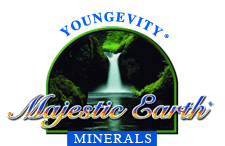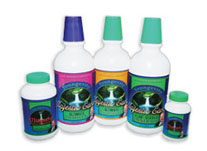Nature's alternative to
Ritalin!
|
|
If there ever was a receipe
that would have been God's for replacement of Ritalin this could
have been it.
The Natural Alternative to Ritalin - $132.80
Includes:
13201 - ME Ult. Classic
13205 - ME Herbal Rainforest
20681 - Ult. OPC-T Capsules
21211 - Ultimate Enzymes Capsules


|
| Attention
Deficit Disorder (ADD ADHD, Hyperkinetic, hyperactive) is characterized
as hyperactivity and/or inability to concentrate and retain information.
Other affects may be disruptive behavior, mean and cruel behavior
towards other children and animals, bed wetting, nightmares and
playing with fire. |
Fact sheet
on Attention Deficit Hyperactivity Disoeder (ADHD/ADD)
|
|
Who has ADHD:
According to epidemiological data, approximately 4% to 6% of
the U.S. population has ADHD.
ADHD usually persists throughout a person's lifetime. It is NOT
limited to children. Approximately one-half to two-thirds of
children with ADHD will continue to have significant problems
with ADHD symptoms and behaviors as adults, which impacts their
lives on the job, within the family, and in social relationships.
Try this test. Have your child
draw a picture of something (age appropriate) before breakfast
(any food). Then have them draw the same picture shortly (30
minutes) after their breakfast and compare the pictures. You
might be amazed at the difference in the pictures. Make sure
the breakfast is a normal breakfast for the child - cereal, juice,
whatever they normally eat.
|
|
Is it ADD? or
ADHD? Whats The Difference?
The difference
is mainly one of terminology, which can be confusing at times.
The "official" clinical diagnosis is Attention Deficit
Hyperactivity Disorder, or ADHD. In turn, ADHD is broken
down into three different subtypes: Combined Type, Predominantly
Inattentive Type, and Predominantly Hyperactive-Impulsive Type.
Many people use the term ADD
as a generic term for all types of ADHD. The term ADD has
gained popularity among the general public, in the media, and
is even commonly used among professionals. Whether we call it
ADD or ADHD, however, we are all basically referring to the same
thing.
|
|
Definition of ADHD:
ADHD is a diagnosis applied to children and adults who consistently
display certain characteristic behaviors over a period of time.
The most common core features include:
- distractibility (poor sustained attention
to tasks)
- impulsivity (impaired impulse control and
delay of gratification)
- hyperactivity (excessive activity and physical
restlessness)
In order to meet diagnostic criteria, these
behaviors must be excessive, long-term, and pervasive. The behaviors
must appear before age 7, and continue for at least 6 months.
A crucial consideration is that the behaviors must create a real
handicap in at least two areas of a person's life, such as school,
home, work, or social settings. These criteria set ADHD apart
from the "normal" distractibility and impulsive behavior
of childhood, or the effects of the hectic and overstressed lifestyle
prevalent in our society.
According to the DSM-IV (the Diagnostic and Statistical Manual
of Mental Disorders, Fourth Edition) some common symptoms of
ADHD include: often fails to give close attention to details
or makes careless mistakes; often has difficulty sustaining attention
to tasks; often does not seem to listen when spoken to directly;
often fails to follow instructions carefully and completely;
losing or forgetting important things; feeling restless, often
fidgeting with hands or feet, or squirming; running or climbing
excessively; often talks excessively; often blurts out answers
before hearing the whole question; often has difficulty awaiting
turn.
Please keep in mind that the exact nature
and severity of ADHD symptoms varies from person to person. Approximately
one-third of people with ADD / ADHD do not have the hyperactive
or overactive behavior component, for example.
|
| Many
people (children and adult) are proscribed Ritalin or Prozac.
These drugs are designed to chemically subdue the person. According
to many parents and professional people, the side effects of
these drugs are significant and include biochemical and emotional
addiction (a child drug addict), drooling, drowsiness, and explosive
behavior (violence, suicide, etc.) |
| Many
people have tried alternatives to Ritalin and had great success.
They have achieved this success often by removing all alcohol
and sugar (natural or processed) from the diet. Educating the
ADD/ADHD victim that there is a connection between sugar consumption
and their negative behavior. They say it is important for the
whole family to eat the same way if this dietary approach is
to be successful! Plant derived colloidal lithium, chromium and
vanadium are specific supplements these people have found to
be useful. Evidence shows it is best to take all 90 essential
nutrients. |

Minerals are essential to
life itself!

|


Doctor Joel Wallach and his Pig Pack
Formulacan be for those that are one of the 20 million
Americans who has listened to Doctor Wallachs "Dead Doctors Don't Lie!
- the audio tape by Dr. Joel Wallach, BS, DVM, ND, The Mineral
Doctor? Doctor Wallach has advocated that this formula may comfort
those with artthritis pain and associated joint problems.
Pig Pack Formula from Youngevityy has made ordering
the products for the Pig Pack Formula much easier. You can buy all those products at one
time. Included in the pig pack is 2 Majestic Earth
Minerals #13203, 2 Majestic
Earth Ultimate Tangy Tangerine #13221, 1 Ultimate
Gluco Gel #21251 and 1 Ultimate
E.F.A. #20641 .
Look also at our
Liquid
Gluco Gel with MSM,
Glucosame Sulfate, Chondroitin Sulfate, Cetylmyristoleate, and
Collagen Hydrolysate. Check out Liquid
Osteo fx an easy way to get your 1200mg of Daily Calcium
with MSM and Glucosame Sulfate.
Pig Pack Wholesale Price:164.95


|







